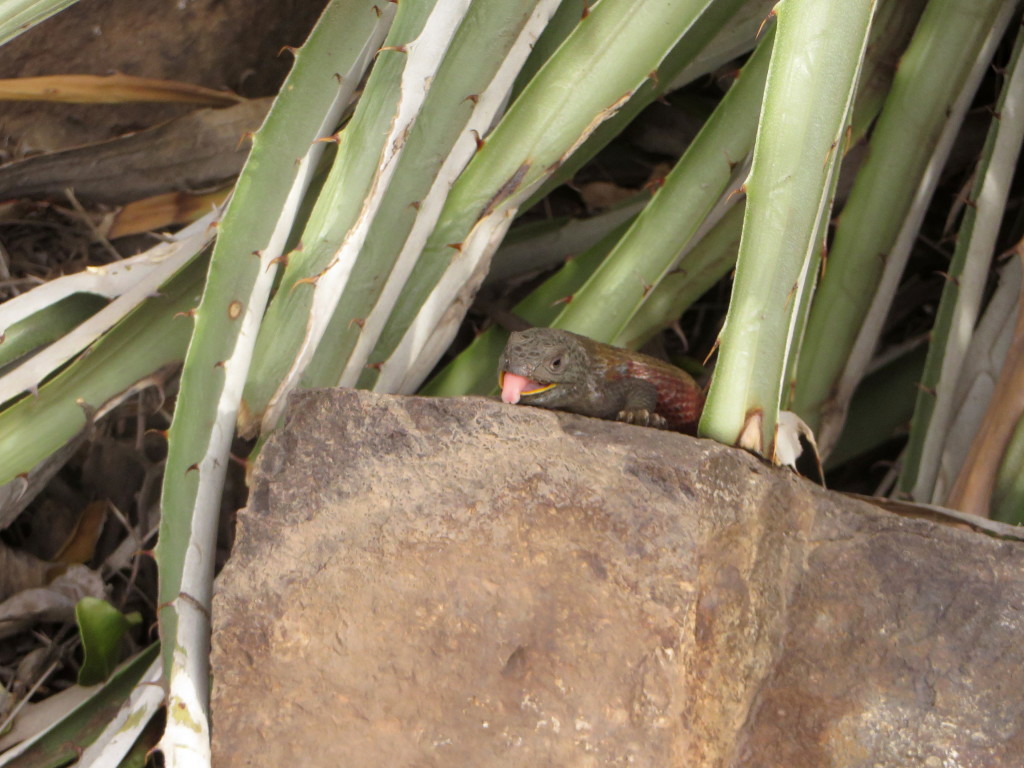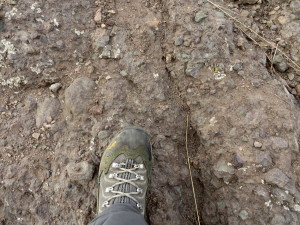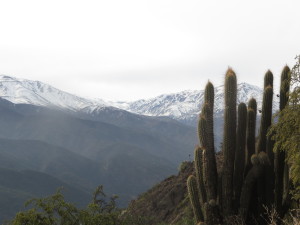The Andes are Santiago’s backyard, and Cerro Pochoco is one of the most accessible routes to explore them. This short (but steep) walk brings trekkers a spectacular 1100m (3600ft) above central Santiago, and the barren landscape offers spectacular views at every point.
This post will give a quick picture of the geography around Santiago, then an account of the trek. Directions to the trailhead, by car and by public transport, are at the bottom.
Mountains around Santiago
Santiago is a flat, 40km wide valley hemmed in on both sides by mountains. Last week, we visited the Cordillera de la Costa which separates Santiago from the sea. This week we go east into the Cordillera Principal, which is the edge of the Andes. All of these Cordilleras (kȯr-di-yeh-ruhs) refer to large scale mountain chains stretching hundreds or thousands of kilometers along the edge of the continent. The figure below shows a cross-section of the Andes (red line), highlighting the two Cordilleras and the Central Valley around Santiago. 
The Cordillera Principal is growing. At the edge of South America, two continental plates are colliding. The seam is a deep ocean trench 100km off the coast of Chile. There, the oceanic Nazca Plate is being subducted under the South American Plate. The force of the collision is buckling and thickening the South American plate to form the Andes.
The resulting uplift is large in geological terms: 0.3mm/year. In human terms, that’s an imperceptibly tiny number. That’s one skyscraper’s worth of height every million years. The construction of the Empire State Building was thirty thousand times that fast, and the Burj Dubai was fifteen times faster still. That’s something to remember next time your local contractors seem slow.
The Andes, however, are 100km wide and an unbelievable 7000km long. To lift an area that large, even by a fraction of a millimeter, means moving an enormous amount of mass. To use the skyscraper example, the Andes move the weight of about a million Burj Dubai’s per year (some of this is invisible under the surface). That’s something to remember next time a human city seems large.
Into the hills
I set out for Cerro Pochoco after a leisurely Saturday lunch. I took the Santiago metro, then the bus, and then walked for half an hour through the outskirts of the city between gardens full of aloe and flowering succulents.
Finally, I reached a dead-end gate at a small astronomical observatory. A dusty, unmarked path curved along the wall and up towards the hills. I started up. The climb is steep, and I’m out of shape after living in Santiago’s smog. I was overheating in my T-shirt before I even set foot on the trail. Two birds of prey circled overhead and I wondered if they were waiting for me.
The rocks underfoot were a pleasant mix of volcanic flows, in different colors and textures, and volcanoclastics. Those are volcanic flows which picked up broken fragments of other rocks as they were deposited.
The rocks here are some 25 million years old, which means they were laid down as the Andes were rising. Yet the forces which lifted them a kilometer into air have left surprisingly few marks. The bedding planes are all straight, with little visible fracturing or folding. The only evidence of the compression the region is experiencing are large, gentle folds on neighboring mountains. The picture below shows a 300m section of Cerro Provincia. Bedding planes are clearly steeply inclined on the mountain flank, but near-horizontal on the top, indicating that the mountain is formed by a large open fold. 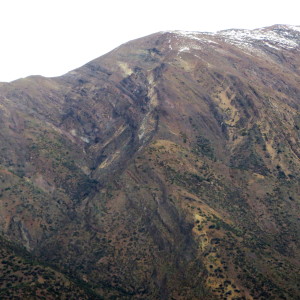
Rocks bend under pressure, like cloth or card. The greater the compressing pressure, the tighter the resulting fold. If the rock is strong (like card under gentle pressure), it will fold once with a consistent curve. This is what we see above. If the rock is weak (like paper), then under gentle pressure it may form many smaller folds. Rocks fold more easily when they are hot or buried deep underground. Since these rocks didn’t fold easily, we can assume that they were not deeply buried. This fits with their history. 25 million years ago, lava poured out onto the surface of Chile, one layer after another. As the Andes rose, they folded slightly under pressure. But that’s it. They weren’t buried or twisted along the way.
While thinking this through, I scrambled up to the summit of Cerro Pochoco (top photo). The hike up til now had been pretty. Here, it became spectacular. The glacier-bitten edge of Cerro El Plomo and the interior Andes began to peek out in the distance. The ridge ahead was blissfully flat. I spent a few minutes drinking tea and taking in my last sight of Santiago, then set off. The Cordillera is charming in winter. I walked in my T-shirt down a dusty, desert-like path with cacti at my elbows and snowy mountains on either side.
My target was a low peak at the end of the ridge. I had set myself a strict turnaround time of 5:45 to make sure I made it down before dark. With lots of huffing and puffing and a little bit of last minute sprinting, I made my summit at 5:44.
The view was thrilling. Unlike the mountains I’d been walking on, which had straight slopes and rounded ridge tops, the Precordillera has been glaciated many times. Its slopes are curved and its ridges are knife-edged. I marveled, and meditated… and then spent a happy half hour trying to take the perfect summit selfie.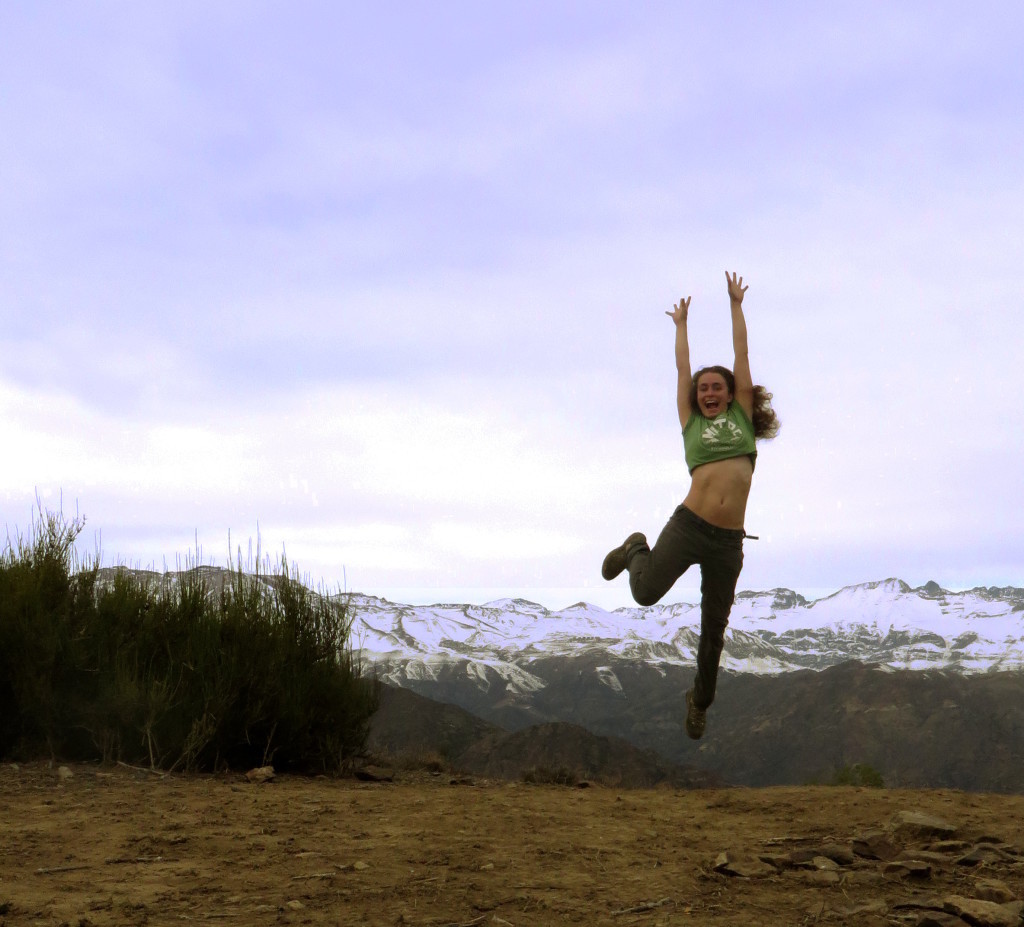
Do you think I got it? (Read on for directions to the trailhead) Reaching the trailhead By public transport: Take Metro Line 1 to Manquehue. You will exit onto Las Condes, a major road. Go to nearby bus stop Parada 4, and catch the C01 bus west. Ride the bus for twenty-four minutes (give or take traffic) to Plaza San Enrique. This stop is easily recognizable because it is the last stop on Las Condes. The bus heads straight west-northwest towards the mountains until the Plaza, then it turns sharply left. The trailhead is at the Pochoco Observatory, 3.2km from the plaza. Wikiexplora has a useful map with driving directions. From the plaza, follow Paster Fernandez to the west. You will cross a small bridge, then turn north and follow a deep gorge. Make a very sharp left onto Camino El Cajon. The next turn (~400m) is a steep stairway on your right, marked with a small brown sign. At the top of the stairs are two Catholic shrines. This is Camino El Alto. Turn left, and follow the road until it ends in the Observatory parking lot. The trail is just past the Observatory, and begins its climb along a barbed wire fence. The trail unmarked, but well worn. It ascends directly on a ridgeline and is easily followed.
